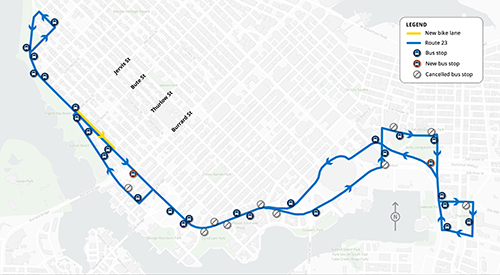

Vancouver has an extensive bus network with more than 50 routes in the city and over 1,800 bus stops. More than 350,000 people use these stops every day.
We work in partnership with TransLink and Coast Mountain Bus Company to install and maintain all bus stops throughout Vancouver.
Our goals are for all bus stops in Vancouver to be safe, convenient, accessible and comfortable for all residents.
How we improve bus stops
- Adding signs to indicate the bus stop and pull-in/out area
- Improving the sidewalk and accessibility at the bus stop
- Making sure that utility poles, street furniture, and landscaping does not interfere with bus doors
- Providing seating, litter bins or shelter when space is available
- Reinforcing road surface to support the weight of buses
- Trimming or removing landscaping encroaching on sidewalk or impacting sightlines
- Extending the bus stop to accommodate longer or more buses
- Moving the bus stop for operational efficiency
- Improving integration with pedestrian crossings, sidewalks, and bikeways
Current bus stop improvement projects
Don’t park in bus stops
When vehicles are parked in or too close to a stop, this can create unsafe conditions for people using a bus; especially those with wheelchairs, mobility aids, low vision, or strollers.
We are installing signs to clearly show where vehicles can and cannot park to make sure buses can operate safely.
Does a bus stop need attention?
Contact us
Email: [email protected]

